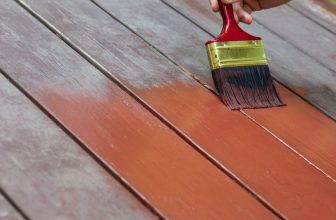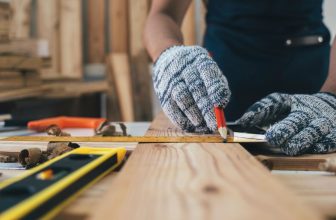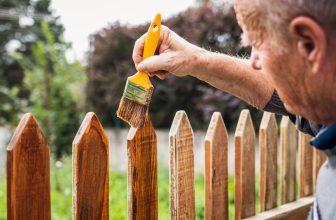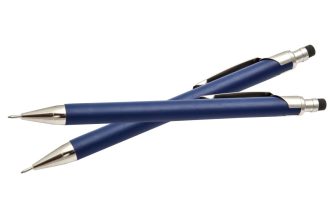Contents
An HVLP spray gun, or a High volume, low-pressure device, has a range of uses where it can be used for garden fences, cabinets, furniture, bikes, and even cars in some cases, but if you’re starting out, there’s a lot you may not know about spray painting.
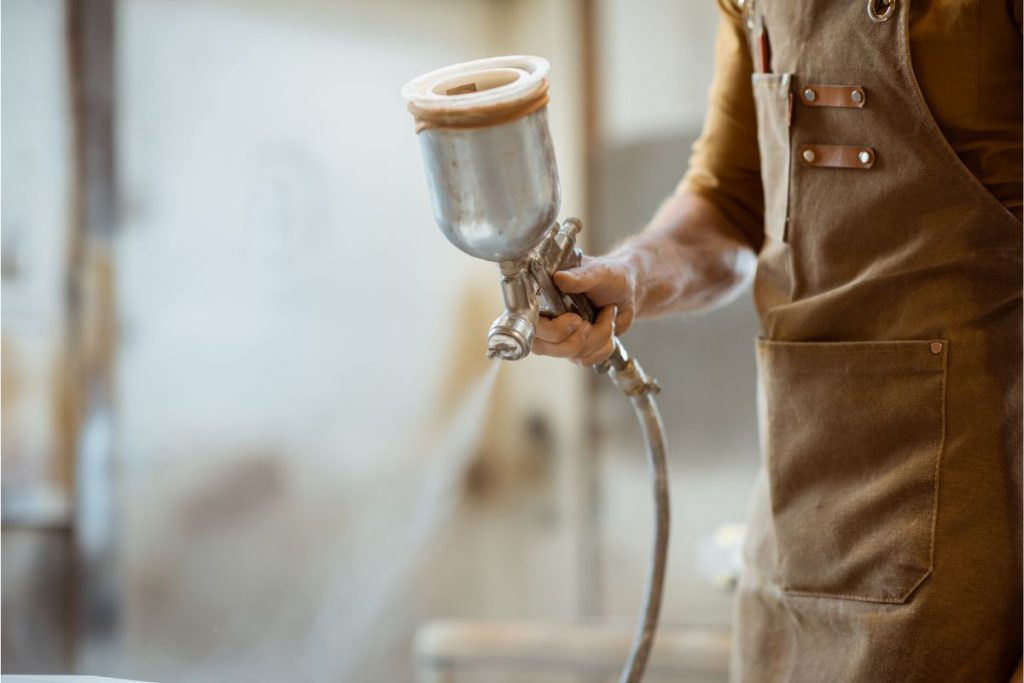
That can be because there are a lot of items that come with the gun and many specifications you might not fully understand, so getting it right the first time can be difficult, but it doesn’t have to be.
Below you can find the best spray guns for your next project as we go over each in detail to help you choose which is ideal for you, and we have included a buyer’s guide, which is followed by the most asked questions to answer the most common questions that arise.
Our Top 3
The 7 Best HVLP Spray Guns For Woodworking
This gun takes advantage of HVLP to atomize materials like paints into fine particles and give you a smooth finish on trims, decks, furniture, or any wood that needs a coat, with adjustable settings where you can easily control the paint flow.
You can turn the air cap to spray horizontal, round, or vertical, you get a 20 foot hose to help you reach all areas of your project, and it gives you a better hold on the handle so that you can use it for those lengthier and more challenging jobs.
This gun not only gives you three spraying patterns, but you also get three tips for different materials, so you can get more power with less paint thinning, which makes your paint go further for those more expansive areas, like fences.
You get 450 watts of power to the spray, and it uses a good variety of paints, ranging from latex to primers, chalk, stains, and sealers, and the simple design won’t have you scratching your head when looking for control features as they’re clearly marked.
With this gun, you get a high-speed motor and powerful turbofan which makes the paint distribute much faster while giving you a smooth finish as the gun adopts a 150 DIN viscosity so that you can use more paint types with it as well.
You get some pretty helpful features such as the quick-release head, adjustable flow knob, and a shoulder strap to make the unit easier to move around, so you can get accurate output and saves paint levels, so it isn’t wasted while on small painting jobs.
This compact spray gun system gives you no-bleed results with an adjustable pattern fan control, a 400cc gravity cup, a metal turbine case, and a 25 ft hose with an air control valve to prevent overspray and bounce back.
The spray cap is a standard 1.3mm air cap, ideal for spraying thin to medium materials, and has a stay-cool handle, so it is helpful for prolonged uses where you may be in a tight space, as it’s relatively comfortable to use.
This spray gun has been designed to give you more output without having to do any extra work to make it possible, as you have a 500 w motor with easy-to-use controls so you can optimize your system for the conditions you’re working in.
You have plenty of options on how you use it, from fences, external walls, decor, cabinets, and anything else you can think of, so you’re not limited based on the ambition you have when faced with a paint job and rollers just won’t do.
This kit has everything you need to get started, from the various tools and accessories you get straight from the case, which includes two spray guns, a locking air pressure regulator, a nylon and plastic cup with lid, and two spanner wrenches.
Not only this, but the gravity feed design means you can minimize waste from residue in the tank, saving you on paint, which can be difficult at the best of times to determine how much you need to complete a job.
This spray gun has a look that many DIY enthusiasts will be more familiar with. You have a 1-liter non-drip stainless steel cup that translates to a great surface coating performance with fine atomization and is easy to maintain.
You also have a fully adjustable broad fan pattern control with three knobs for fluid, pattern, and air pressure controls, which is ideal for medium to large-size painting jobs and can be used in the home, or outside.
Buyers Guide
Perhaps you have found the spray gun that you’ve been looking for, but hold on there, as there are other considerations you need to make before you purchase any set, which can make your experience easier and safer.
You can find more detailed considerations below that can trip up any beginner user of these paint guns, and some of these may require you to purchase additional accessories, and the most important of them all, the compressor.
Air Pressure For Your Gun
The operating range is between 15 and 50 psi, so it’s a good idea to learn beforehand how to adjust the pressure from the compressor, so you can regulate the pressure and have an even paint job. Though, for some paint spray kits, you can do different types of paint jobs.
These include touchups, shading, sunbursting, airbrushing, and finish materials, so you want a device that can do all of these, even f you only intend to go for one type of finish.
If you never want to use a paintbrush again, it’s a good idea to have a flexible sprayer.
Safety Supplies
Before you go purchasing a spray gun, there is a list of equipment you need to get to use the device safely, and these are paint, thinner, cleaning tools, stir stick, well-ventilated area, respirator, nitrile gloves, safety glasses, long pants, and long sleeve shirt.
This is a lot of gear that is not for show but can prevent particles of paint from getting in your lungs, on your skin, and even in your eyes, and is even more important when going for different consistencies, so you can adjust the air-fluid or fan knobs if needed.
Ease Of Assembling The Spray Gun
In general, most kits will give you instructions on how to assemble and clean the gun, but there are things like nozzles, patterns, and other attachments that you might find, and some are better with different types of paint than others, so you might have to make some tweaks.
The Wagner Spraytech, for example, works with thinned latex paints, stains, polys, and oil-based paints, so if you only need this in your process for a fine finish, you should be fine with this one, but be sure to check the label of the paint you intend to use.
Frequently Asked Questions
What’s The Difference Between A LVLP And HVLP Spray Gun?
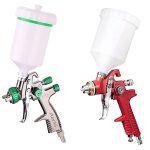
These can be difficult to identify as even though they look similar, they have different outputs and applications. Hence, an HVLP sprayer gives you high volume and low pressure, so they can be turbine and pneumatically driven.
An LVLP sprayer is uses low air volumes combined with low pressure and requires less power to operate than an HVLP, which makes it compatible with almost any compressor type. The shooters exist only as compressor-driven units.
If you’re wondering which one is best for your job, the HVLP variety is more effective in small to midsize projects as the LVLP ones have a smaller fan pattern which will take you longer to complete tasks.
The LVLP requires a compressor that delivers around 15 to 35psi, compared to 25-30 psi for the HVLP, and can go up to 40 psi where higher atomization is needed, so you might be able to save on the costs of a compressor, but you might not get the spread you’re looking for.
How Do I Test My Compressor With The Spray Gun?
First of all, ensure you have the correct safety gear on to prevent any incidents, especially if you’re new to this, and safely connect your gun to the compressor by the hose and any other accessories.
Then you should ensure that the compressor is delivering the adequate CFM, which should be around 10-12, but for an optimal measure, look in the instructions that come with your device, and then you can mix your paint and solvent to the correct ratios.
Before you get to work on your job, test the pressure sprayer pattern on a piece of cardboard or a spare piece of wood so you can see if you get a consistent paint flow. You can make any adjustments to the knob, which should be on the side of the gun.
What If There Is A Problem With My Gun?
Finding the source of the problem will take some trial and error as some issues aren’t as visible as others, but there are some things you can check to prevent other issues from happening later on.
Some of these include tightening or loosening the packing nut, replacing the fluid tip, using the wrong size needle or tip, having a low material level, unclogging air vents, having the wrong consistency of material, too high air pressure, and holding the gun too far or too close.
These are just a few fixes you can try out, and if these don’t solve your problem, you may have a fault on the gun if you find that the compressor works with other units, so you may have to replace this or any parts that come with the spray gun.
The Bottom Line
The emphasis has been on HVLP spray guns, but you may find other alternatives, but as long as your job is successful and you don’t use more paint or material than is necessary, you should have a great short-term solution.
For the longer term, though, an HVLP spray gun set is highly recommended for bigger jobs where using paint rollers is too much of an inconvenience, or you may not be very good at doing it this way, as it does take a degree of skill to get an even finish.











